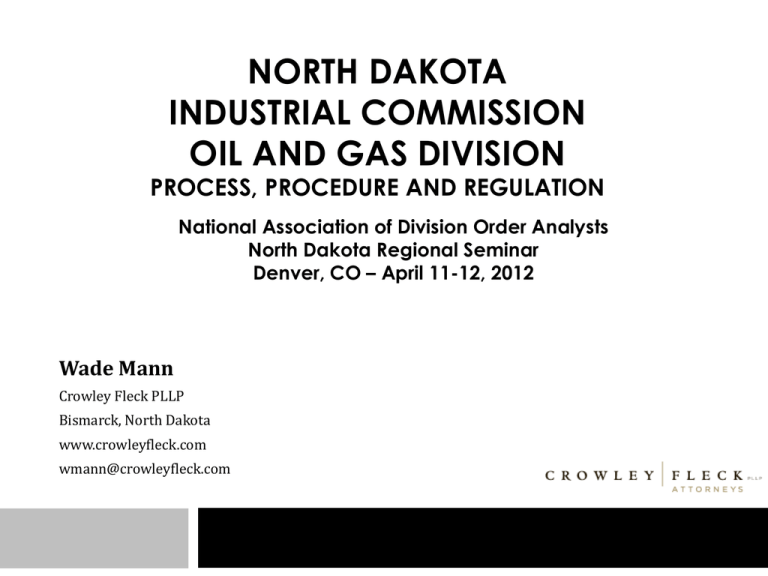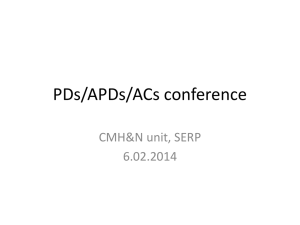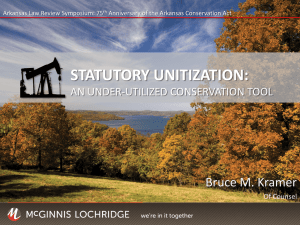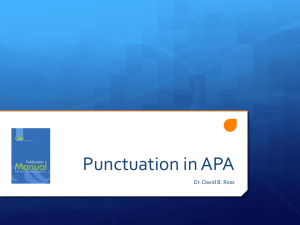North Dakota Industrial Commission and TAT Tax Issues
advertisement

NORTH DAKOTA INDUSTRIAL COMMISSION OIL AND GAS DIVISION PROCESS, PROCEDURE AND REGULATION National Association of Division Order Analysts North Dakota Regional Seminar Denver, CO – April 11-12, 2012 Wade Mann Crowley Fleck PLLP Bismarck, North Dakota www.crowleyfleck.com wmann@crowleyfleck.com North Dakota Industrial Commission (“NDIC”) • What is the Commission all about? • Makeup of the NDIC • History and organization - NDAC § 43-01-01-01 • Governor • Attorney General • Agriculture Commissioner Department of Mineral Resources • NDCC Section 38-08-04.2 • The industrial commission is authorized to appoint a director of mineral resources who shall serve at the pleasure of the commission. The director of mineral resources shall carry out the duties of the director of oil and gas along with the duties of director of mineral resources. The commission may set the salary of the director of mineral resources. The commission may delegate to the director of oil and gas all powers the commission has under this title and under the rules enacted under this title. NDIC Oil and Gas Division • Director – Lynn Helms • Assistant Director – Bruce Hicks Regulation of Oil and Gas in ND • Regulation of Oil and Gas Resources • Governed by North Dakota Century Code Title 38 • Primarily in NDCC Chapter 38-08 • North Dakota Industrial Commission (“NDIC”) • rules relating to oil and gas exploration and development are set forth in Article 43-02 of the North Dakota Administrative Code NDCC Ch. 38-08 gives the NDIC jurisdiction of oil and gas exploration and production North Dakota Oil and Gas Regulatory Policy • NDIC is guided by the following statutory policy mandate: • It is hereby declared to be in the public interest to foster, to encourage, and to promote the development, production, and utilization of natural resources of oil and gas in the state in such a manner as will prevent waste; to authorize and to provide for the operation and development of oil and gas properties in such a manner that a greater ultimate recovery of oil and gas be had and that the correlative rights of all owners be fully protected; and to encourage and to authorize cycling, recycling, pressure maintenance, and secondary recovery operations in order that the greatest possible economic recovery of oil and gas be obtained within the state to the end that the landowners, the royalty owners, the producers, and the general public realize and enjoy the greatest possible good from these vital natural resources. Application Process • Notice • • NDCC Section 38-08-11(1) requires notice either in accordance with NDCC Chapter 28-32 (i.e. personal service) or by publication in the Bismarck Tribune and newspaper of general circulation in the county where the lands lie, at the election of the Commission NDAC Section 43-02-03-90(2) provides that except in contested cases with a specific named respondent, notice is to be given by publication Notice • Exceptions to notice by publication are: • Contested cases with a specific named respondent • Exception locations • Compulsory unitization • Due Process Implications Monthly Hearings • Commission has published hearing schedule • Includes hearing dates and deadline for filing applications (“Docket closing date”) • Docket closing date is generally about one month • before the hearing date i.e. Docket closing date (deadline for filing application) for May 30 and 31, 2012 hearings is April 27, 2012 • Hearings generally held the last week of the • month Two days of regularly scheduled hearings Telephonic Testimony • Requires written request in advance of hearing – generally include in application rather than as separate request • • • Two business days for applicant, three business days for any other party Policy not to use telephonic testimony in contested Requires attorney or other representative to be present in the hearing room and affidavit to be filed after testimony is given Affidavits • NDAC Section 43-02-03-88.1 • Certain routine matters can be handled by filing affidavit instead of presenting witnesses and exhibits • Poolings Hearing Process • Presided over by Hearing Examiner • Procedural hearing examiner – handles • • procedural and legal formalities Does not conduct any questioning on substantive issues Assistant Attorney General • NDIC Staff • Conduct all of the questioning on substantive • issues in application Generally 3-5 NDIC staff present at hearings Petitions for Reconsideration and Appeals • NDCC Sections 38-08-13 and 38-08-14 • Generally NDCC Chapter 28-32 procedures apply • Appeal to the state district court in the county where the lands lie Common Disputes • Size of spacing unit • Mineral owners vs. operator • Competing operators • Issue is which size spacing unit will result in “efficient and economical development of the pool as a whole” NDCC Section 38-08-07(2) • “Uniform size” unless zones of spacing are necessary to protect correlative rights, prevent waste, or prevent the drilling of unnecessary wells. NDCC Section 3808-07(1) Common Disputes • Operatorship • NDAC Section 43-02-03-16.1 • Recognizes that majority owner/largest owner should • usually be operator Exceptions related to relative ability of contestants and contractual obligations Common Disputes • Unitization disputes • Usually relate to designation of operator, unit boundaries, unit formula, or method of operation Common Disputes • Pooling disputes • Penalty issues • Adequate opportunity to elect, reasonable offer to lease Spacing • NDCC Section 38-08-07 – “when necessary to • prevent waste, to avoid the drilling of unnecessary wells, or to protect correlative right” Modifies rule of capture • Texaco v. Industrial Commission of State of North Dakota, 448 N.W.2d 621 (N.D. 1989) • Uniform size and shape for a pool • Zones Spacing • Temporary vs. Proper Spacing • Temporary – upon discovery of pool • Proper – 18 months after tempory • Either temporary or proper is subject to modification • Amoco Production Co. v. North Dakota Industrial • Commission, 307 N.W.2d 839 (N.D. 1981); Hystad v. Industrial Commission, 389 N.W.2d 590 (N.D. 1986) “Collateral estoppel” or “res judicata” is loosely applied Spacing • Vertical – correlation to depth • Rectangular – 40 acres, 80 acres, 160 acres, 320 acres, 640 acres • • “Diagonal rule” Horizontal – correlation to lateral length • Rectangular – 640 acres, 1280 acres, 2560 acres • Infill wells (additional wells on spacing unit) • Allowed by NDCC Section 38-08-07(4) • Reasonably uniform pattern Spacing • Drilling unit vs. Spacing Unit • NDAC Section 43-02-03-18 • Statewide well location rule • NDCC Section 38-08-07(3) and NDAC Section 43-02-03-18.1 • Exception location – legal location would not produce in paying quantities, surface conditions would substantially add to burden or hazard of drilling, or when otherwise necessary to protect correlative rights, prevent waste, or effect a greater ultimate recovery of oil or gas, or when surface issues Spacing • Drilling unit vs. Spacing Unit continued • Drilling unit Orders • Stand-up, on-pattern 1280’s for most of undrilled Bakken area Pooling of Spacing Units • Terminology • “Pooling” – consolidating the interests in a • spacing unit for purposes of drilling and production “Unitization” – consolidating the interests in a pool (or portion thereof) • Typically for “enhanced production” • Secondary or Tertiary production • Waterfloods • High Pressure Air Injection • CO2 Pooling of Spacing Units • Pooling • Required to prevent an unconstitutional taking of property • Spacing – restricts right to drill in a reservoir • Pooling ensures all in a spacing unit get their fair share of production from the well(s) allowed to be drilled on the spacing unit • Spacing does not pool in North Dakota • Schank v. North American Royalties, 201 N.W.2d 419 (N.D. 1972) Pooling of Spacing Units • Methods of Pooling • Voluntary Pooling Agreement • Requires joinder by all mineral/royalty owners and working interest owners • Declaration of Pooling • Requires pooling authority in oil and gas leases • • Restrictions on exercise Forced Pooling/Compulsory Integration Pooling of Spacing Units • NDCC Section 38-08-08 • Spacing Unit • Separately owned tracts or separately owned interests • within tracts Absence of voluntary pooling • Continental Resources, Inc. v. Farrar Oil Co., 550 • N.W.2d 841, 1997 ND 31 – authorized by police power Texaco v. Industrial Commission of North Dakota, 448 N.W.2d 621 (N.D. 1989) - retroactive to date of first production Pooling of Spacing Units • Non-consent Penalty • Risk of drilling operations • Not fair that one party incur all the risk and other parties benefit from that act • Compensation for taking risk in form of “nonconsent penalty” or “risk-compensation” • NDCC Section 38-08-08 provides for risk penalty • 200% for lessee under oil and gas lease • 50% for unleased mineral owner Pooling of Spacing Units • Non-consent Penalty • NDCC Section 38-08-08 • Provides in part that “if the owner of an interest in a spacing unit elects not to participate in the risk and cost of drilling a well thereon, the owner paying for the non-participating owner’s share of the drilling and operations of a well may recover from the nonparticipating owner a risk penalty …” • Neither the right to recover nor the amount of risk penalty is discretionary with Commission Pooling of Spacing Units • Non-consent Penalty • Right of owner to “elect” • NDAC Section 42-03-02-16.3 establishes requirements for invitation to participate • Location and depth of well • Itemization of estimated drilling costs • AFE or Authorization for Expenditure • Spud date • Response date • 30 days • Notice of intent to collect risk penalty and right to object • May be required to file a petition for a hearing to object Pooling of Spacing Units • Unleased mineral owners – Special Issues • “Cost free royalty share” • Unleased mineral owners entitled to a cost-free royalty before payout – NDCC Section 38-08-08(1) • “acreage weighted average royalty” • Alternative 16% royalty • Pooled after July 31, 2009 • Operator’s election to pay 16% or acreage weighted average Pooling of Spacing Units • Unleased mineral owners – Special Issues • Right to lease • Additional prerequisite to recovery of penalty is a reasonable offer to lease • Need not be the highest or best offer in the spacing unit • “Professional mineral owners” are not entitled to any better • offer than any other mineral owner Communications between oil company and mineral owner cannot be misleading or contain inaccuracies Unitization • Voluntary Units • NDCC Section 38-08-09 • • Recognizes validity of voluntary unit agreements Binding only upon those who execute • Early cases recognize policy of state to promote secondary recovery • Syverson v. North Dakota Industrial Commission, 111 N.W.2d 128 (N.D. 1961) • Voluntary units valid and binding, improper to inject on tract that is not fully committed Unitization • Compulsory Units • Allowed if reasonably necessary to carry on pressure maintenance or re-pressuring operations, cycling operations, water flooding operations, or any combination thereof, “or any other form of joint effort calculated to substantially increase the oil and gas from the common source of supply” NDCC Section 38-08-09.1 Unitization • Compulsory Units • Special procedures are required • • • Copy of petition including proposed plan of unitization must be mailed to all owners 45 days before the hearing Copy of all technical exhibits must be filed with the Commission 45 days before the hearing Plan of unitization must be ratified or approved by owners of 60% of the royalty interest and 60% of the working interest • Can occur after the Commission approves the unit, but must then occur within 6 months after Commission order approving the unit Unitization • Compulsory Units • Once approved by the NDIC and ratified by 60% of royalty and working interest owners, effective against all interests included within the unit area Unitization • Compulsory Units • Allocation of expenses and production • • All “tracts” within the unit bear their share of the expenses of developing and operating the unit and receive their share of revenues from production Allocation is based on production and reservoir characteristics instead of just surface acreage Unitization • Compulsory Units • Allocation – NDCC Section 38-09-04(2) – factors • Two Phase Formula Preference • Phase I – intended to approximate what would be recovered by individual spacing units without unitization • Emphasis on current production rates, remaining primary production • Stays in effect until “trigger” is met • “Trigger” is the estimated volume of oil that would have been recovered under primary production – i.e. without the unit Unitization • Compulsory Units • Allocation – NDCC Section 38-09-04(2) – factors • Two Phase Formula Preference • Phase II – begins when trigger is reached, intended to approximate contribution to secondary (tertiary) recovery • More emphasis on “reservoir” characteristics – net feet of pay, original oil in place, etc. • Correlation between such factors and contribution to secondary recovery Unitization • Expansion of Units • NDCC Section 38-08-09.9 • • • Governs enlargement of units Method for avoiding necessity of getting expansion ratified by all owners in existing area Typical unit agreement requires that in the event of expansion, the ratio of ownership in the existing unit not be changed • Existing unit is typically treated as a single tract in an expanded unit Unitization • Unit Agreements • Govern rights between all owner (royalty and • • • working interest) within the unit Approved by the NDIC Standardized forms “Federal Units” – more than 10% of unit (surface acreage basis) owned by the United States • Must use Federal Unit Agreement form prescribed by BLM Unitization • Unit Operating Agreement • Govern rights between working interest owners • How decisions are made and costs are borne NDIC Resources • NDIC Oil and Gas Division website - tremendous resource • https://www.dmr.nd.gov/oilgas/ Tribal Tax Agreement • Three Affiliated Tribes Oil and Gas Tax Agreement • Authorized by NDCC Chapter 57-51.2 • Generally imposes an effective tax rate for all Trust lands of 11.5%: • 5% gross production tax on oil • Flat tax of $0.04 per mcf escalated on gas • 6.5% extraction tax on oil Tribal Tax Agreement • Three Affiliated Tribes Oil and Gas Tax Agreement • 50% of tax revenues collected by the State on • • Trust lands paid over to Three Affiliated Tribes Effective tax rate on Fee lands is 5% for the first 60 months and then 11.5% Three Affiliated Tribes receives 20% of the taxes on fee land Tribal Tax Agreement • Three Affiliated Tribes Oil and Gas Tax Agreement • Provides that Three Affiliated Tribes will not levy any taxes or fees on oil or gas activity or interests within the reservation other than a one-time $60,000 TERO fee on each well and a “tribal application fee” of $40,000 on each well considered to be on Trust lands • Well considered to be “on Trust Land” and subject to the $100,000 permit fee if a majority of the lands included within the spacing unit are trust lands Tribal Tax Agreement • Three Affiliated Tribes Oil and Gas Tax Agreement • Terminable by either party upon 30 days notice to • the other Provides that any well drilled during the term of the agreement would be subject to taxes under the Agreement for the life of the well








